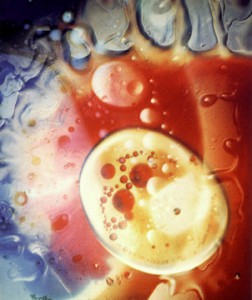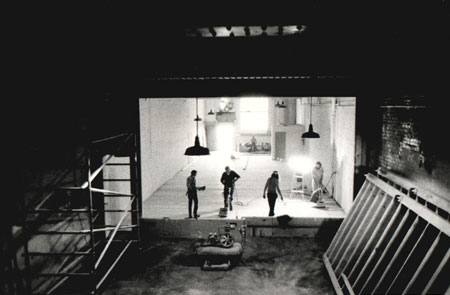INTRODUCTIONS



Painting with Light an Old Chapter in Artistic Utopia
Nearly half of a century ago, Hans Richter stated: \”There had to be a final break with the absurd prejudice that problems in the art of our times could only be resolved through oil painting or bronze.\” Although the light show would appear to have its ancestry firmly rooted in the soil of twentieth century painting, this has scarcely been acknowledged. Even a brief (and incomplete) survey of earlier efforts to combine music and visual effects, including Castel\’s \”ocular harpsichord\”, Kastner\’s \”Pyrophone\”, the work of Jameson, Bishop and others as well as Scriabin\’s light keyboard: for his \”Poem of Fire\” and the cinematographic projection of Survage, Eggeling, Richter and Leger seem ample evidence of the light show\’s artistic legitimacy. In addition, the work, both theoretical and actual, by artists at the Wemar Bauhaus is further proof, that as Moholy-Nagy stated in Vision In Motion:
Painting with light is an old chapter in artistic utopias… today there are more technological sources for light painting than at any other period of human history. But this is not yet the age of light painting. It is only the hour of light advertising… light as a new medium will infuse vitality into the ever recurring problems of life. It will bring forth a new form of visual art and as we go forward from painting with brushes and pigments toward painting with instruments and light, there must be confidence that the achievement will not impair the directness, nor lower the spiritual level of painting.
In 1965, unaware of any of the previous work mentioned above, while working with brushes, pigment and other conventional materials, in the general style called action painting or gestural abstraction, I made my own discovery of the electric wall plug via the transparent overhead projector and began working with light (projected imagery) and music. This was for me a natural extension of the techniques and purpose of action painting including a direct spontaneous method of working. And so, while the traditional elements of painting continued, several important new factors had to be dealt with, including: (1) the orchestration of time; (2) impermanence; (3) scale [amplification] (4) relationship to music; and (5) relationship to viewer-observer.
The transparent overhead projector has certain qualities that have allowed development in a direction, in some ways quite different, from most of the light art previously cited. In particular, the flat surface above the condensing lens allows for the direct application of materials during projection. Unlike film or the projection of slides, the painter is able to work directly with color and other materials in a manner similar to drawing and painting techniques.
This light art, like music, unless recorded, is totally impermanent. \”Action painting that ceases with the action.\” Painting that exists only during the time of its creation. This orchestration of time becomes as important for the painting as for the musician. The relationship of space-amplification (very similar to the musicians\’ use of sound-amplification) becomes significant and allows the freedom of scale sought by painters in action painting. The small works of Wols, as well as Klee and Kandinsky, are similar in scale to the working surface of the overhead projector. And at the same time, the scale of immensity developed by Pollock, Kline and others was further extended by the properties of projection to allow for large surfaces of instant art. These qualities of momentariness, impermanence and free scale required a new painter-viewer relationship. This is an art form in which the artist and viewer share an immediate experience, where composition, execution and presentation occur simultaneously.
My work with light art and projection has followed two parallel directions in realizing the possibilities of projected imagery with music. The principal difference is not so much the purpose or techniques involved, but more specifically the attitude of the viewer-listener, which can be defined as active or contemplative. In the natural evolution of studio work the observer assumed a contemplative, passive role common to previous painting and music. The other situation involves physical participation and is more related to happenings and events art, and culminating in the original SF rock dances at the Avalon and Fillmore.
The early STUDIO WORK and first public presentations in January, 1966, of the three week \”Vision in Motion\” series were examples of the contemplative-observer situation. This work originally involved the exclusive use of the overhead projection system, allowing me to work directly and spontaneously with music in a manner not common to previous (or for that matter subsequent) light art. The use of several overhead projectors at once, has facilitated both the development of a continuum of imagery orchestrated in time, and the \”live mix\”, within the performance, of imagery, simultaneously projected and superimposed, This live mix quality has been further developed with he use of slides and films when appropriate. The close working relationship with music in the execution of extended spontaneous works has not (to the best of my knowledge) been duplicated by any other painter. With Fred Marshall and Jerry Granelli at the Light Sound Dimension Theater a particularly productive period of work in this form resulted. This unsalaried artist collective produced approximately a year and a half of weekly performances.
\”Light and sound improvise together for an hour at each showing. No one hour is ever like another. And there is probably no theater like this one anywhere else on earth.\”
A. Frankenstein, SF Chronicle
The closing of the theater due to financial pressures eliminated this unique regular performance situation. I have since continued my research in various studio spaces and presented public performances in France, Switzerland and the Bay Area.
My earliest work involving a more active participation or physical awareness for the spectator, was the original light show at the Avalon Ballroom Family Dog dances. In that situation, using multi-image techniques, including slide, film, strobe and other special effects, as well as my own distinctive use of the overhead projector with liquids, the light show provided a four to five hour performance-environment whose impact and intensity had seldom been achieved by previous art \’happenings\’. These weekly performances did much to popularize and establish the basic form for the \”rock dance light shows\” that followed.
In less than two years, there were too many \”light show groups\” to count in the immediate San Francisco Bay Area. In addition to the supply-demand factor, the rapid commercialization of the music quickly resulted in the extermination of the \’happening-performance-environment\’ nature of the dances.
\”The band was in the light show. If you were in the audience, you didn\’t know who was plaing. Not at all. It was sensory thing.\”
Eric Clapton, SF Chronicle
Although it took a year or two, the overwhelming focus on pop-music record-industry values and promotion techniques soon forced all other considerations aside, effectively eliminating the light show in that form. (It should be noted that the video disc, which still hovered off in the future, would have made this fragmentation much more difficult.) While the majority of light shows that appeared during this brief alliance with rock-music perished, my work was not fatally affected.
I have continued to work on occasional large scale event-type productions since the demise of the local rock light-show \”scene\”. This has included large outdoor performances with various forms of music in Europe as well as several large scale works since my return to San Francisco, including a benefit performance in Grace Cathedral for the \”Longest Walk\” and two Tribal Stomp production at the Greek Theatre, University of California at Berkeley in 1978 and at the Monterey Fairground in September, 1979. And a LIGHTSOUNDIMENSION performance at the Herbst Theater, 1979.
– STUDIO WORK –
The development of spontaneous projection painting required a parallel development of space for research and practice. The painter\’s abandonment of conventional media and the inadequacies of presentation policies for contemporary visual art prompted him to design and construct several light sound studios. These studios have provided an important laboratory space for the technological developments necessary as well as opportunity for sustained experimentation and practice.
As one cannot rehearse spontaneity, the studio sessions have never been related to as rehearsals. Rather, the impermanance and present tense qualities suggested from the beginning a policy of viewer/listener participation in studio work.

